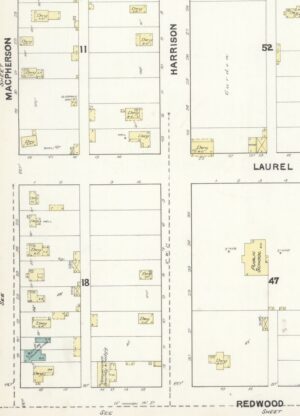
Sanborn Map of 1890 showing the location of an early Chinese laundry near the corner of Redwood Avenue and Macpherson Street in Fort Bragg. (Sanborn Fire Insurance Map from Fort Bragg, Mendocino County, California . Sanborn Map Company, Nov, 1890. Map. https://www.loc.gov/item/sanborn00551_001/.)
The earliest documentation of the Chinese presence in Mendocino County is clearly shown in the town of Mendocino. It would seem the natural migration of the Chinese should be seen in Fort Bragg in the late 1850s, shortly after they appear in Mendocino, but that is not the case.
Newspapers and maps help confirm the presence of Chinese people and businesses in Fort Bragg. The earliest such documentation are the Sanborn Fire Insurance Maps, beginning in 1890, which show Chinese laundries operating in several places near Redwood Avenue and Macpherson Streets.
In 1892, newspapers give additional support of Chinese here when the Union Lumber Company brought Chinese laborers up from the Bay Area to work under contract digging the tunnel for the now called Skunk Rail Lines.
The news describing how the community greeted the arrival of these Chinese laborers was reported throughout California. On the evening of January 18, 1892, the laborers were met by over one hundred white men, including prominent people who incited the local workers to attack the Chinese at their campsite along Pudding Creek. Some reports stated it was instigated by outsiders, but others spoke of locals participating in the attack. The word used was “molested,” a polite word for the attack.
The laborers were gathered up and escorted to the Noyo River and told to keep walking south and not to return. When they arrived in Mendocino, they were taken in at Carlson’s City Hotel, which was next to Mendocino’s Chinatown on Main Street, and given medical attention.
The next day, the sheriff arrived to escort the Chinese laborers back to Fort Bragg under protective custody. The Union Lumber Company played a major financial role in the county at that time, and the judge issued an order for the sheriff to act. In the next election, neither the judge nor the sheriff were re-elected. The laborers did complete their work as contracted.
There were two pivotal Chinese families in the Fort Bragg Chinese community, that of Lee Chew Fun (Mr. Lee) and Helen Quong. Mr. Lee, who was indirectly related to the Lee family in Mendocino, was here from 1911 to 1916, according to an oral history of Jerry Lee, a grandson.
Starting with a kitchen job, Lee worked his way up to sous chef and then finally chef, earning fifty dollars a month. This amount wasn’t enough to pay off monies he owed in China, so he took a second job as cook for a laundry.
Eventually, he was able to open the Eastern Grocery Store on Harrison Street and Redwood Avenue. Lee also organized an employment referral office for Chinese immigrants and raised funds for Dr. Sun Yet Sen. He later moved to San Francisco and opened the Eastern Bakery on Grant Avenue in Chinatown. In the 1930s, Lee would send mooncakes to the Quong’s in Fort Bragg. The bakery is still operating to this day.
Another influential Chinese person to leave her mark on the community was Helen Quong, who moved to Fort Bragg when she married Chan Quong in 1930. Her son, Ben Quong, related that his father worked for Union Lumber Company at Camp 2 during the week, coming home on Saturday, and then would go back to the camp on Sunday. This meant that Helen was left to raise her family on her own during the week. In an oral interview in the book “Fort Bragg Remembered,” Helen recounts how very lonely she was, calling her father every week. Helen’s father owned a store in San Francisco and would send her groceries and other items on a regular basis.
In 1933 Helen and her family returned to San Francisco, but a few years later the Quongs came back to Fort Bragg because Chan did not want to stay in San Francisco. Ben remembered few Chinese living in Fort Bragg in the 1930s. The Quongs originally lived on McPherson Street and later moved down to Redwood Avenue below McPherson.
Helen was an entrepreneur, creating a business that bought dried sea algae and reselling it in Chinatown. She later bought Café Rivera, located on Main Street between Alder and Redwood, although she did not really know how to cook. All her endeavors were to help support her family. She and her husband ran the café for quite some time.
The standout in Ben’s interview is that his mother was a strong woman with no fear. Once, she confronted a father whose son was bullying her children. When she was threatened, she stood her ground and spoke back to him. This was unheard of at this time, and she was Chinese. Helen was a pioneer in her own right in the Fort Bragg community, as well as in her culture. The legacy of these two families may seem minor but left a globalmark.
Sanborn Maps can be viewed and downloaded from the Library of Congress website.